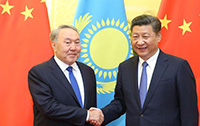Free trade deals could be future of Asia-Pacific
(english.cntv.cn) Updated: 2015-11-23 22:32By Yu Xiang, director, division of American economic studies, associate research fellow, Institute of American Studies, China Institutes of Contemporary International Relations(CICIR)
At the Asia-Pacific Economic Cooperation (APEC) Summit in Manila, Philippines on Nov. 18-19, United States President Barack Obama had reassured other 11 TPP (The Trans-Pacific Partnership) members that they would benefit if deal is ratified by US Congress.
Some APEC member states did not sign the TPP, making for an awkward ending of the summit, which jointly declared G20 countries should embed inclusive growth at the heart of its agenda.
Meanwhile, the TPP favors exclusiveness, but the FTAAP (Free Trade Area of Asia-Pacific), represents a broader free trade area, which could be the economic future of the Asia-Pacific.
FTAAP is larger in size and holding greater influence. FTAAP is 10 percent bigger than the TPP, which consists of 40 percent of global GDP. A bigger economic entity could create a more sophisticated impact and improve the Asia-Pacific's welfare.
According to a forecast by the Peterson Institute for International Economics, TPP would yield global annual benefits of $US295 billion, while benefits from a broader regional free trade arrangement could reach a bigger volume, $1.9 trillion.
FTAAP is an all-inclusive free trade agreement. TPP claims itself as a "21st century agreement" that will be comprehensive, high quality and beneficial to developing and industrialized members.
But the diverse economic structures of its members and several years of difficult negotiations indicate the TPP treaty must be compromised, or many loopholes would prevail.
Democratic Party presidential candidate, US Senator Bernie Sanders Vt.-D.) said when he saw the final text, his feeling was "It's even worse than I thought." Leading Republican Party presidential candidate Donald Trump labeled it "insanity."
Compared with TPP, FTAAP can be more flexible over controversial issues such as intellectual property rights, services, investments, government procurement, labor and environmental standards, and some exceptions could be granted to accommodate new entrants, which can be more acceptable for regional countries.
What's more, TPP is not a "rival" to FTAAP, but could be a "stepping stone" toward a broader FTAAP. The existing TPP could be the fastest way to move forward. Connecting the TPP with other FTAAP economies may be realized by additional agreements.
FTAAP is developing fast, and has turned from a proposal to real action. Though it was put up as early as 1980s, until 2014, FTAAP had achieved a major breakthrough in 2014 with China's endorsement.
When China hosted the 2014 APEC summit, Beijing supported FTAAP, emphasizing it would reduce fragmentation caused by the wealth of separate, non-inclusive free trade agreements in the region.
In the 10th G20 summit in Turkey, Chinese President Xi reiterated the importance of FTAAP for regional connectivity. The Chinese initiative has been well received by the international community at large.
FTAAP meshes with China's "One Belt and One Road" initiative as part of a move toward regional economic integration. It will reduce policy barriers to trade, while the "One Belt and One Road" would facilitate physical movement of goods due to increased infrastructure connectivity.
Although it's not easy to conclude the FTAAP as an important path to realize "inclusive growth," yet it could be the future of the Asia-Pacific, encouraging all parties to take an inclusive attitude in the process.




